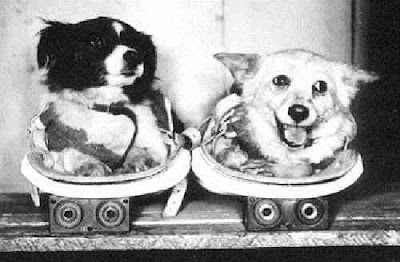Dogs (and cat) of space
Routine Mission (1955-01-25): A simple SR-2a sounding mission that succeeded with no complications.
Routine Mission (1955-06-25): This mission necessitated a modified version of the SR-2d with the second stage engines and fuel removed and the first stage power reduced somewhat. This made the rocket slow enough to be capable of re-entry, allowing for the returning a biological experiment. It was a successful mission.
Routine mission (1955-11-23): For this mission we were tasked with taking up an 'advanced biological payload' in a sub-orbital trajectory and returning it. The modified re-entry capable SR-2d was selected for the job. Buddy the dog has successfully returned to Earth safely without any issues and earned his wings!
Historical Aside: The first dogs in to space were strays called Tsygan and Dezik, sent up as early as 1951 on R-1 rockets. Dezik perished on a second flight after the parachute on their capsule failed. Tsygan survived the programme and would be adopted by one of the physicists ("Let the hero come and live with me"), There were many other space dogs throughout the period.
 |
| Tsygan and Dezik o7 |
Most well-known of all is the famous dogmonaut Laika, travelling up with Sputnik 2 at the very end of 1957 on a one-way orbital mission. While the mission was considered successful, its cargo was never intended to survive the trip. Laika died very early in the mission due to overheating after an air conditioning failure. Even had everything functioned as intended, the Sputnik 2 had no re-entry capabilities.
 |
| Laika o7 |
Routine Mission (1956-04-08): Another, tougher, mission to study animals on spacecraft. Lily the cat returned to Earth without incident, becoming the very first cat in space.
Historical Aside: The first (and only) cat in space in real life was named Félicette and launched much later in 1963 on a Véronique rocket from the very pad we're using in our fictional space program.
Félicette's fate was unfortunately much sadder than Tsygan's; the scientists on the project euthenised her to perform a post-space travel necropsy that would have, obviously, been unacceptable on human subjects.
 |
| Félicette, the first and only catmonaut o7 |
Our research and development in to rocketry has increased significantly over the past year and a half when these missions took place. We are now ready to design a vehicle capable of taking a satellite to orbit. I don't want to jinx it, but it looks like we're firmly ahead of the US and Soviet space programs.
Soon the Space Race will begin.
Next Post: The big one: Getting to orbit




Comments
Post a Comment